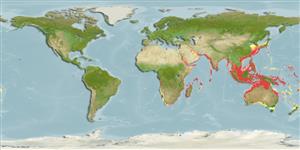Environment: milieu / climate zone / depth range / distribution range
Ecology
Marine; brackish; demersal; oceanodromous (Ref. 51243); depth range 0 - 200 m (Ref. 30573). Tropical; 35°N - 36°S
Indo-West Pacific: Persian Gulf and east coast of Africa (south to Algoa Bay and perhaps to Knysna, South Africa) to Fiji, north to southern Japan, south to the northern coast of Australia.
Length at first maturity / Size / Weight / Age
Maturity: Lm 16.5, range 16 - 17 cm
Max length : 45.0 cm TL male/unsexed; (Ref. 6804); common length : 30.0 cm SL male/unsexed; (Ref. 9774)
Dorsal spines (total): 0; Dorsal soft rays (total): 71 - 84; Anal spines: 0; Anal soft rays: 53 - 62; Vertebrae: 36. Some pairs of moderately large canines in anterior part of both jaws, 6 to 13 lateral teeth in lower jaw, stronger and more widely spaced than those of upper jaw. Gill rakers pointed, longer than broad. Soft ray count of pectoral fin refers to that on ocular side (Ref 9774).
Found in shallow waters and estuaries, on mud and sand bottoms, to depths of 200 m (Ref. 30573). Juveniles common in brackish water (Ref. 9774). Feeds on benthic animals (Ref. 5213). Mainly sold fresh (Ref. 9774).
Life cycle and mating behavior
Maturities | Reproduction | Spawnings | Egg(s) | Fecundities | Larvae
Distinct pairing (Ref. 205).
Desoutter, M., 1986. Bothidae. p. 428-429. In J. Daget, J.-P. Gosse and D.F.E. Thys van den Audenaerde (eds.) Check-list of the freshwater fishes of Africa (CLOFFA). ISNB, Brussels; MRAC, Tervuren; and ORSTOM, Paris. Vol. 2. (Ref. 6804)
IUCN Red List Status (Ref. 130435)
Threat to humans
Harmless
Human uses
Fisheries: commercial; gamefish: yes
Tools
Special reports
Download XML
Internet sources
Estimates based on models
Preferred temperature (Ref.
123201): 21.4 - 28.5, mean 27 °C (based on 1365 cells).
Phylogenetic diversity index (Ref.
82804): PD
50 = 0.5000 [Uniqueness, from 0.5 = low to 2.0 = high].
Bayesian length-weight: a=0.00589 (0.00478 - 0.00725), b=3.16 (3.11 - 3.21), in cm total length, based on LWR estimates for this species (Ref.
93245).
Trophic level (Ref.
69278): 4.2 ±0.7 se; based on diet studies.
Generation time: 6.9 ( na - na) years. Estimated as median ln(3)/K based on 1
growth studies.
Resilience (Ref.
120179): Medium, minimum population doubling time 1.4 - 4.4 years (K=0.16; tmax=7).
Fishing Vulnerability (Ref.
59153): Moderate to high vulnerability (49 of 100).
Nutrients (Ref.
124155): Calcium = 105 [47, 197] mg/100g; Iron = 0.9 [0.5, 1.7] mg/100g; Protein = 16.9 [14.8, 18.9] %; Omega3 = 0.154 [0.076, 0.302] g/100g; Selenium = 62.3 [26.9, 142.5] μg/100g; VitaminA = 25.3 [6.7, 101.3] μg/100g; Zinc = 0.9 [0.6, 1.4] mg/100g (wet weight);
